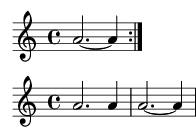

In the key of C major, this would be the C-major chord (I) and the G-major chord (V). That is, the chords built on the first and fifth notes of the scale. The first principle is the supremacy of the tonic (I) chord and the dominant (V) chord in the harmonic structure.

Two cardinal principles of tonal music form the foundation of Schenker's theory as an intrinsic part of the way we hear and perceive music. There are a few simple steps to understanding a Schenker graph and how it represents an analysis of a piece. Armed with a working knowledge of Lilypond and with the techniques explained in this article, any user should be able to produce beautiful Schenker graphs-and some other forms of advanced musical notation-in less time, with less effort and difficulty than when using a graphical music notation application. I also assume that the user is using Lilypond 2.6, though most of the tools I cover are valid for any 2.x version of Lilypond.
#Lilypond tie code#
I assume that the reader has at least a basic knowledge of Lilypond, and thus give instructions only for the nonstandard code used for Schenker graphs. In this article, I cover the creation of a Schenkerian graph that contains all of the most common Schenkerian notational elements, with explanations of what each element signifies and the code required to produce it. This makes Lilypond a powerful tool for creating Schenkerian notation graphs, which-by their nature-require extreme control of positioning, as well as the masking and hiding of notational elements. Additionally, its text-to-music rendering method makes it easier for a typesetter to control hidden elements. Lilypond not only produces beautiful sheet music, it also puts a great deal of control at the user's fingertips.
#Lilypond tie mac os x#
The Open Source world, however, has an excellent music typesetter in GNU Lilypond, which now runs natively on Linux, Mac OS X and Microsoft Windows. Schenkerian Analysis, as it is called today, is a staple of music theory, but it is notoriously difficult to notate using the industry-standard, proprietary music notation applications Finale and Sibelius.

To illustrate his theory, he created a notational system that clearly depicts these relationships. In the early twentieth century, Heinrich Schenker developed a method of analyzing tonal music that ties a piece's melody, harmony and form to a simple underlying musical idea.


 0 kommentar(er)
0 kommentar(er)
